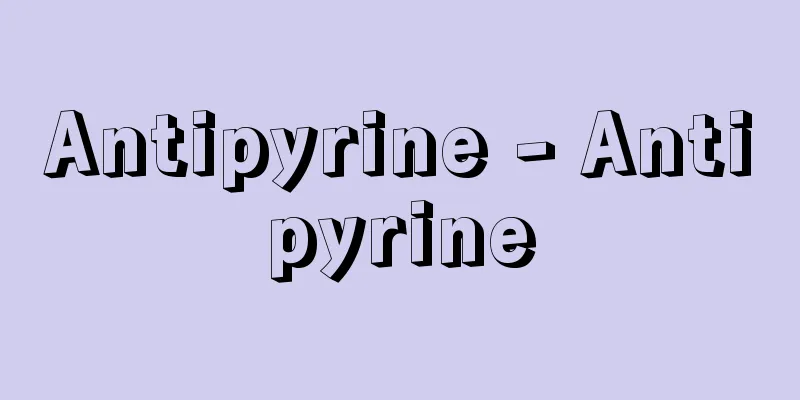Antipyrine - Antipyrine

|
Antipyretic and analgesic. Created in Germany in 1884, it was sold by Hoechst. It is the original form of pyridine, and is an odorless white crystalline powder with a slightly bitter taste. Side effects include hypersensitivity symptoms such as rash and redness, as well as rare nausea, vomiting, loss of appetite, blood disorders, liver disorders, and kidney disorders. Aminopyrine, isopropylantipyrine, and sulpyrine were developed to alleviate these side effects and increase their effectiveness, and like aminopyrine, they are not used much these days. It is a powerful drug, and the usual dose is 0.3 grams per dose, 0.6 grams per day, and the maximum dose is 1 gram per dose, 3 grams per day. [Fumiji Koho] Source: Shogakukan Encyclopedia Nipponica About Encyclopedia Nipponica Information | Legend |
|
解熱・鎮痛剤。1884年ドイツで創製され、ヘキスト社より発売された。ピリン剤の原形で、わずかに苦味を有する無臭の白色結晶性粉末。副作用として発疹(ほっしん)や発赤(ほっせき)などの過敏症状をはじめ、悪心、嘔吐(おうと)、食欲不振、血液障害、肝障害、腎(じん)障害がまれにみられる。この副作用を緩和し、効力の増強を図ったのがアミノピリン、イソプロピルアンチピリン、スルピリンであり、現在ではアミノピリンと同様、あまり使われていない。劇薬で、常用量は1回0.3グラム、1日0.6グラム、極量は1回1グラム、1日3グラムである。 [幸保文治] 出典 小学館 日本大百科全書(ニッポニカ)日本大百科全書(ニッポニカ)について 情報 | 凡例 |
Recommend
Engineering method - Kouteisahou (English name)
An official architectural technique book compiled ...
New building materials
A slang term for newly developed building material...
Shadow flow
One of the schools of swordsmanship. Also known as...
The story of a general who is a good love story
A court-style tale written around the late Kamakur...
The Happiness and End of King Ottokar
…His masterpieces, Sappho (1818), the trilogy The...
Shingon sect
A sect of Japanese Buddhism, also known as Shingo...
Economic Journal
A world-renowned academic journal on economics. It...
Not cut
...The residue left over after soy milk is extrac...
Mitsumata Yariuo (English spelling) Black Dragonfish
A deep-sea fish of the family Odontocetiidae in th...
York (person's name) (English spelling)
…The 48-member expedition left St. Louis in May 1...
Alto drums
…The size of the membrane is slightly larger than...
Lower respiratory tract
A general term for the bronchi, lungs, etc. of the...
Kaberi - Kaberi
…Like many other nomadic people, they passed down...
Yatarabyōshi - Yatarabyōshi
It is also written as Yatara-byōshi or Hattara-byō...
Aquarium - Suizokukan (English spelling) aquarium
A facility that breeds various aquatic creatures ...


![Gohoku [village] - Gohoku](/upload/images/67cb9a57e47ea.webp)






